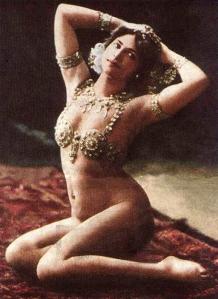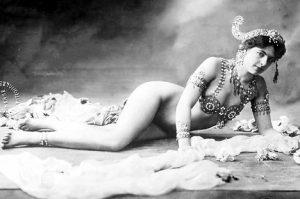
greta garbo as mata hari (1931)
Well, the our project has launched and I’m already racing to finish the next phase of Holiday projects. I haven’t forgotten my new love, however. She is still firmly in my heart and on my mind. You know, I had this one drive home from the studio when I thought of over five REALLY good ideas (well I thought they were at the time) to illustrate the project but by the time I got home, I had forgotten to write them down, thinking that they were so memorable that I would, of course, just remember them. Of course, I did not. Except for Mata Hari. And as the weeks went by and I wracked my brain to remember what I forgot, Mata Hari stayed with me. The seduction had already begun. In fact, the story of Mata Hari had enthralled me years ago when I first saw the fabulous Greta Grabo movie Mata Hari. (I am a HUGE Greta Grabo fan!!! And what an OUTLAW she was… a woman in pants in public!?! But, I digress.) I wanted every single outfit Adrian had created for her; especially the velvet and jewels dress with the fabulous skull-cap and the all black velvet number she goes off to the firing squad in. She was captivating.

fabulous Adrian outfit no.1
I was also really struck by the fictional Mata / Greta ‘s infatuation with the seductive, erotic orchid in whose ‘pouch’? (labia?) she hid her coded messages as double agent. It reminded me of the true to life fascination with orchids and their exoticism / eroticism of the late Victorian and early 20th Century eras. Hmmm… I think I’m on to something: there are many classic perfumes from the 1900’s to 1910’s that mention orchid as a main heart note ingredient. Now this is a good place to start. We know that orchid notes are conventionally ‘fantasy’ notes, somewhat based on olfactive research on the flowers but at that time, many of the orchid accords were rich blends of heady florals, oriental balsams and resins and pure imagination. So, this was the first accord that made it’s way into my consciousness for my perfume Mata Hari, the Vintage Orchid.
The next step was to decide: Oriental? or Chypre? The project by it’s nature makes me lean toward any liberal use of oakmoss but there are tons of spices on the IFRA list as well. Mata Hari was pretending to be Indonesian, of Hindu royal birth, so that sends me in the Oriental direction. But then I had it: a fruity Chypre not only typifies the fragrance chic of the time and place (Paris c.1910-1918), but the fruits speak to Mata Hari’s sensuality while the moss and leather her prowess and sexual abandon (at the time not usually attributed to women). Plus, it wouldn’t be difficult to fit in some oriental references to Indonesia and the Far East as well. Perfect.
The next accord to construct was the leather. Animalic notes can be tricky when using all botanicals to compose, but again, I went for the classical interpretation. Based on birch tar, it’s a smoky, ‘brown’, tanned leather note more so than modern concepts of suede or black leather.

fabulous Adrian outfit no.2 (Greta Garbo with Ramon Navarro)
Another of the focus accords is lilac; notoriously elusive and usually created from synthetics. I felt that lilac would not only pose a challenge but also speak to the ultimate feminine, the “Goddess’ energy at the heart of Mata Hari’s outrageous personality. I worked on a relatively simple accord that I am happy with that approximates some of the aromatic signature of lilac and very much hits all of the ‘pitches’ that lilac hits but there was something about it that resembled tinctured lilacs. It’s got an aged quality that works within the overall design but I do think that I’ll expand the concept in the future. This is the ‘Lilac Cocktail’ accord.
I’m saving the best for last: the fruit note no.1 accord. Peach? Mango? All botanical?? This accord, I must tell you, was the most fun. Composed of citrus, florals and herbs, the fruit note is luscious and juicy with nuances of dried apricots and figs. For me it symbolizes, well, a bustiness…all curves and feminine sexuality.
All told, Mata Hari is replete with the IFRA restricted aromatics… Here’s the list of every botanical included: bergamot, lemon, neroli, orange blossom absolute, mandarin, tarragon, sweet & blood orange, davana, tagettes, galbanum, carrot seed, black pepper, cassie flower absolute, mimosa absolute, jonquil absolute, orris butter, rose de mai absolute, damascena rose otto, sambac jasmine absolute, tuberose absolute, ylang ylang, champaca absolute, osmanthus absolute, nutmeg, cinnamon leaf, cinnamon bark, clove bud, honey absolute, angelica root absolute, ambrette seed co2, benzoin, cistus, costus root, oakmoss absolute, peru balsam, australian sandalwood, styrax absolute, tonka bean absolute, vanilla absolute, cumin, patchouli, java vetiver, buddahwood, texas cedarwood, cassis absolute, myrrh gum, tabac absolute, and cade.
(*FYI: This list is the “full disclosure” list of ingredients. It includes all of the notes used to create the accords as well as single notes to ‘sew’ it all together. This means that some of the ingredients are in minute proportions, included to round out the design, not to show themselves like a parade of stars. Others are focal points and meant to be observed.)
WOW! Just about every bit of this design is from the restricted / banned list! But what can I say? I love these oils; truly and deeply. And I know Mata Hari herself would love them, too.

Read Full Post »







